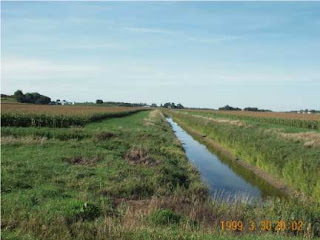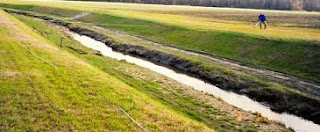
In my last blog entry (I know it’s been awhile) I threw out the water quality concerns associated with artificially drained land. I also mentioned that the face of Indiana today, the agricultural prosperity, and the landscape with which we are accustomed too is a direct result of the importance of artificial drainage. So, I offered up that we will introduce some solutions that help to minimize the water quality concerns with artificial drainage. In this entry we’re going to toss out a relatively new practice that is starting to get some interest around the state and it deals with the exciting topic of ditches! That’s right ditches, generally they are former creeks or streams that have been straightened and completed reshaped for rapid drainage of water. Try to get a hold of yourself, I know that you are probably jumping up and down and screaming with enthusiasm like the new Twilight film just came out! Okay maybe not, ditches are not really something you think about too often or ever, but we do here at ISDA and they are very important. Drainage ditches have had a great deal of impact on the Indiana we know today. For example, have you ever heard of the  Grand Kankakee Marsh in Northwest Indiana? This used to be one of the most expansive wetland complexes in the US, over 500,000 acres. Imagine the mecca for hunting water fowl and fur-trading, truly a wilderness that was the Grand Kankakee.
Grand Kankakee Marsh in Northwest Indiana? This used to be one of the most expansive wetland complexes in the US, over 500,000 acres. Imagine the mecca for hunting water fowl and fur-trading, truly a wilderness that was the Grand Kankakee.
 Grand Kankakee Marsh in Northwest Indiana? This used to be one of the most expansive wetland complexes in the US, over 500,000 acres. Imagine the mecca for hunting water fowl and fur-trading, truly a wilderness that was the Grand Kankakee.
Grand Kankakee Marsh in Northwest Indiana? This used to be one of the most expansive wetland complexes in the US, over 500,000 acres. Imagine the mecca for hunting water fowl and fur-trading, truly a wilderness that was the Grand Kankakee. Well, eventually agriculture was the name of the game for Indiana and much of the marsh was drained by ditches. This allowed for agricultural production and settlement into the area. So, my point is ditches play a critical role in our way of life and in many counties the drainage board is an absolutely critical group who makes important decisions and manages large amounts of public funds to maintain adequate drainage.
A typical ditch is simply a straight channel that is flat on the bottom and has very steeply sloping side slopes for carrying large volumes of water quickly off of the land and lower the water table. The problem is that ditches are rarely built in a way that the shape is sustainable. The velocity of the water along with many other factors cause these ditches to erode quickly and the side slopes fall in, they cost a great deal money to maintain and they really do very little to provide water quality/wildlife habitat. This is where the Two-Stage Ditch can serve as an alternative. The Two-Stage Ditch is built with a channel design with which the bottom section is designed to carry the typical/usual flow of water and then as you move up the side slope there is a grassy flat portion, a “bench”, that is intended to mimic nature’s floodplains, and finally the ditch is angled back up to normal ground elevation of the surrounding landscape.

The design, benefits, and more detailed information can better be found on this link to The Nature Conservancy's site. The Nature Conservancy in Indiana have been relentless advocates and supporters of this concept. Many thanks to them for the science and leg work to get this idea accepted as a viable option.
Without the nitty-gritty specifics the fact is that this simple design alteration to a traditional drainage ditch allows for more capture of sediment and nutrients that would typically shoot right through to the next tributary and on and on. In addition to that the side slopes are more stable providing minimal maintenance costs and because of the vegetated slopes the opportunity for more biological diversity is an improvement.
Without the nitty-gritty specifics the fact is that this simple design alteration to a traditional drainage ditch allows for more capture of sediment and nutrients that would typically shoot right through to the next tributary and on and on. In addition to that the side slopes are more stable providing minimal maintenance costs and because of the vegetated slopes the opportunity for more biological diversity is an improvement.

Here's a typical two stage, notice the grassy bench just above the water level.